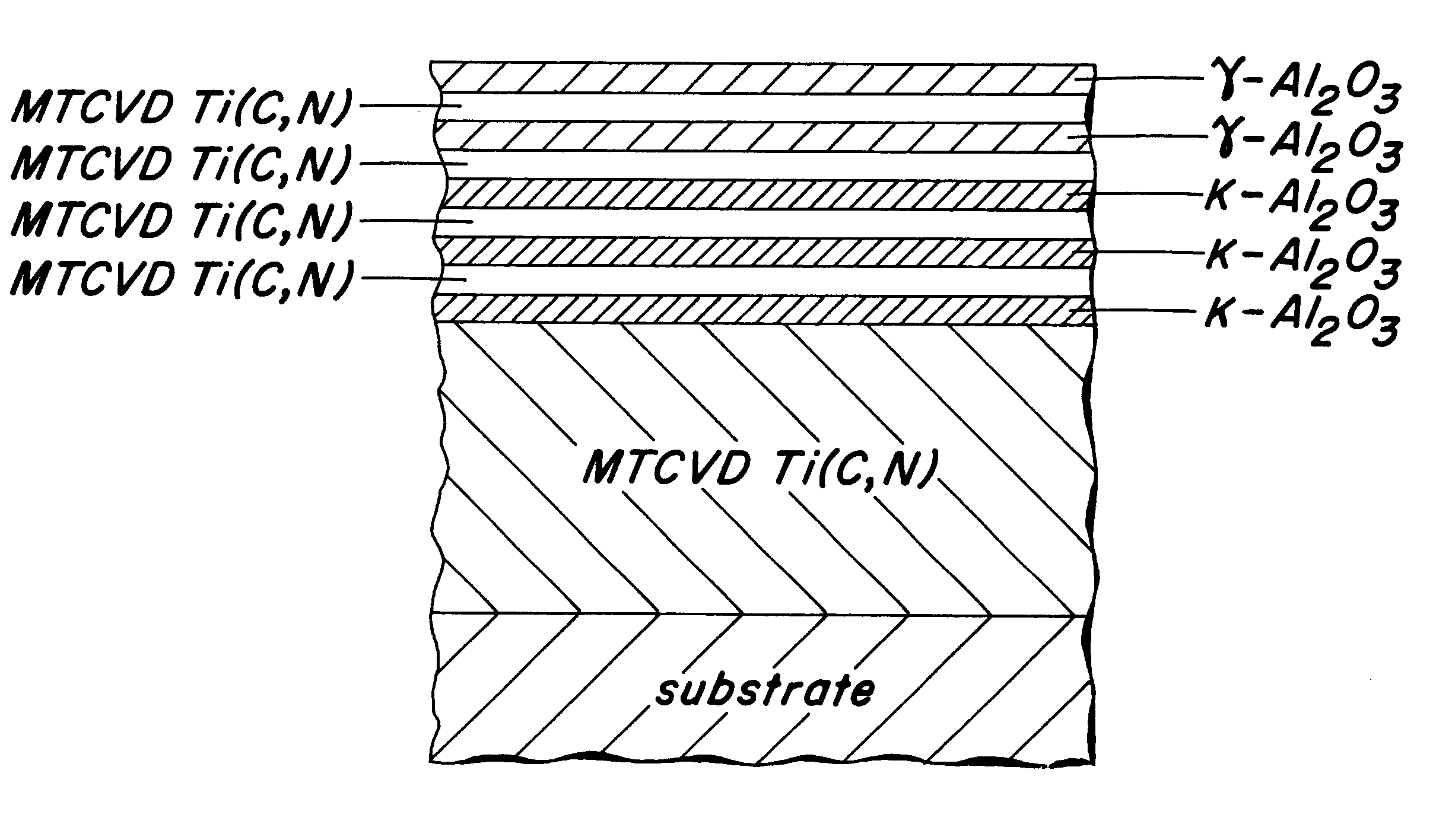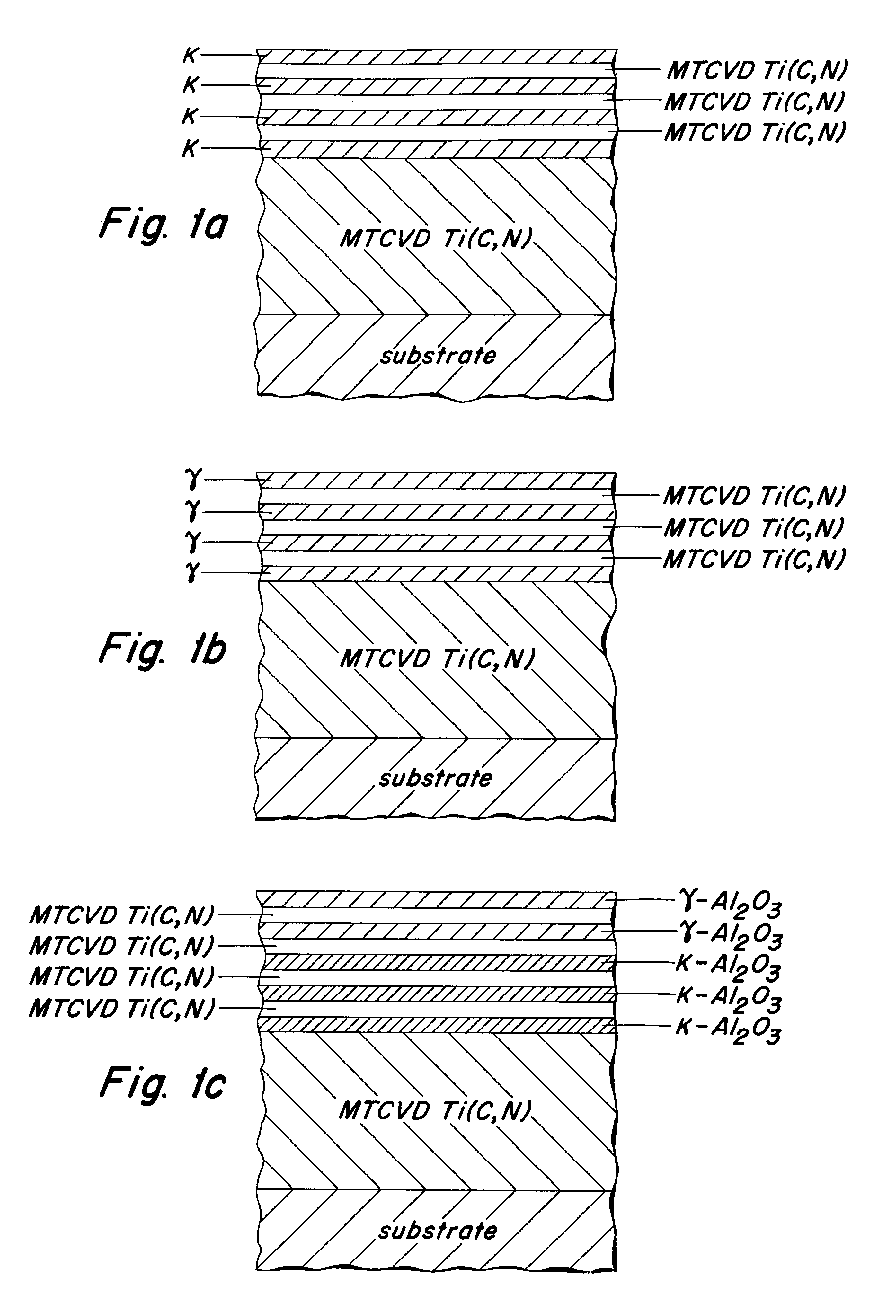Enhanced Al2O3-Ti(C,N) multi-coating deposited at low temperature
a multi-layer, enhanced technology, applied in the direction of instruments, natural mineral layered products, other chemical processes, etc., can solve the problems of adhesion problems in production, the deposition process of prior art multi-layers is relatively long, and the deposition process is usually carried out. achieve the effect of enhancing the wear properties of tin/ti
- Summary
- Abstract
- Description
- Claims
- Application Information
AI Technical Summary
Benefits of technology
Problems solved by technology
Method used
Image
Examples
example 1
Tables 1 and 2 show a summary of the wear properties of different coating in SS1672 and SS2258 (hypo- and hyper-eutectic steels, respectively)
TABLE 2
As can be seen, the coating material may show very different behaviors in these steels. Consequently, different coating structures have to be developed for SS1672 (thin Al.sub.2 O.sub.3 layers+thick Ti(C,N) layers, FIG. 2a) and for SS2258 (thick Al.sub.2 O.sub.3 layers+thin Ti(C,N) layers, FIG. 2b) in accordance with the knowledge of the skilled artisan. Schematics of the optimized coating structures for these steel are shown in FIGS. 2a and 2b.
example 2
Cutting tests were performed in SS1672 and SS2258. The coating, according to FIG. 2a, being composed of 6 .kappa.-Al.sub.2 O.sub.3 layers interspersed by layers of Ti(C,N), (total multi-layer thickness 7 .mu.m) was tested on SS1672 and a coating deposited according to FIG. 2b, being composed of 5 .kappa.-Al.sub.2 O.sub.3 layers interspersed by layers of Ti(C,N) (total multi-layer thickness 7 .mu.m) was tested on SS2258. Cutting tests were also conducted using inserts having single layers of Al.sub.2 O.sub.3, TiN and Ti(C, N) as well as a multi-layer of .kappa.-alumina and TiN were compared. The results are given in Tables 3 and 4.
TABLE 4
example 3
A detailed comparison of the behaviors of a single layer and a multi-layer coating (FIG. 2b) in turning SS2258, is presented in FIG. 3. The multi-layer coating is superior to the single layer SS2258. In this steel, the flank wear is clearly reduced by the Ti(C,N) coatings. It is clear from the SEM micrograph that both crater wear and flank wear resistance of the multi-layer .kappa.-Al.sub.2 O.sub.3 coated inserts were superior to those of the single .kappa.-Al.sub.2 O.sub.3 coated inserts. In this kind of steel where alumina-coated inserts in general perform well, the effects of the multi-layering is very clear. The lifetime of the insert is drastically increased, in particular at 200 m / min more than about 100%. In ball-bearing steel, SS2258 (hypereutectoid steel), a multi layering results in much more drastically reduced wear than observed earlier in hypoeutectoid steels (U.S. Pat. No. 5,700,569).
PUM
| Property | Measurement | Unit |
|---|---|---|
| temperature | aaaaa | aaaaa |
| total thickness | aaaaa | aaaaa |
| total thickness | aaaaa | aaaaa |
Abstract
Description
Claims
Application Information
 Login to View More
Login to View More - R&D
- Intellectual Property
- Life Sciences
- Materials
- Tech Scout
- Unparalleled Data Quality
- Higher Quality Content
- 60% Fewer Hallucinations
Browse by: Latest US Patents, China's latest patents, Technical Efficacy Thesaurus, Application Domain, Technology Topic, Popular Technical Reports.
© 2025 PatSnap. All rights reserved.Legal|Privacy policy|Modern Slavery Act Transparency Statement|Sitemap|About US| Contact US: help@patsnap.com



